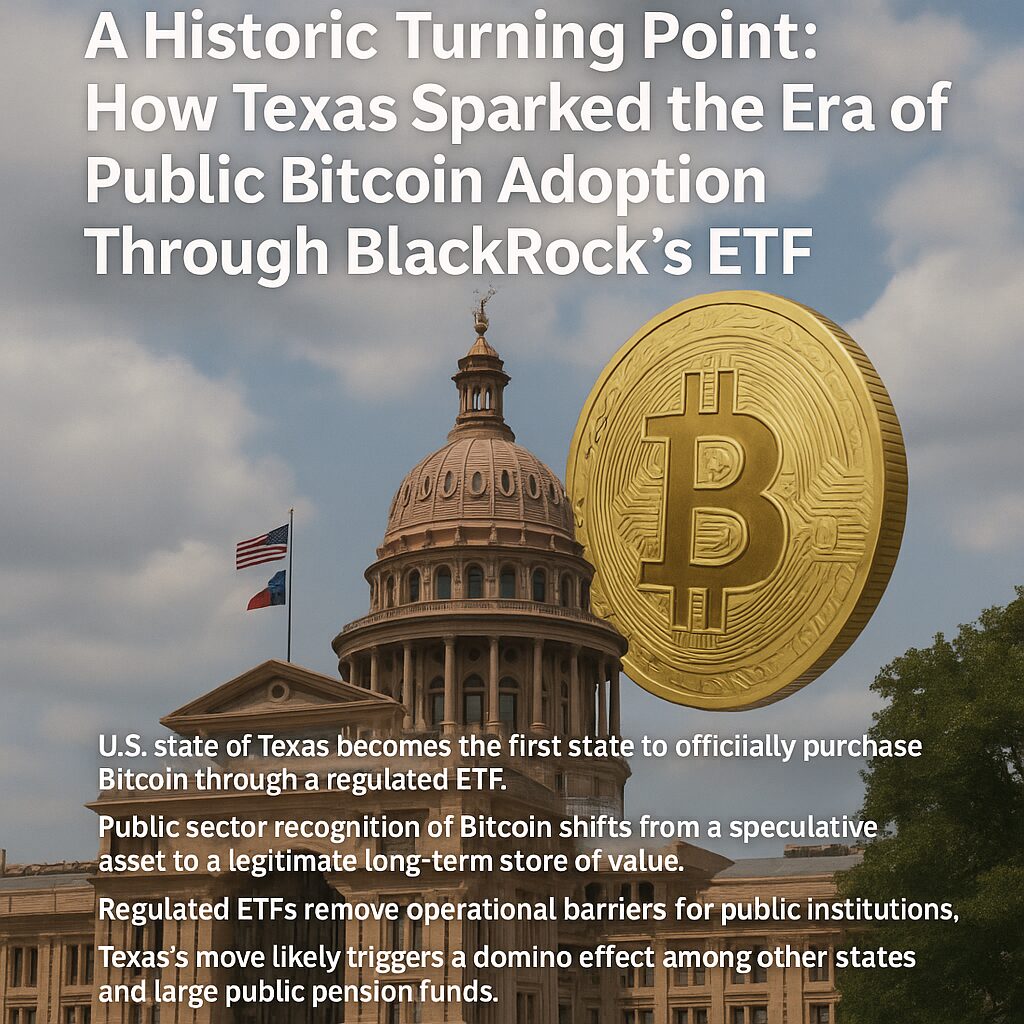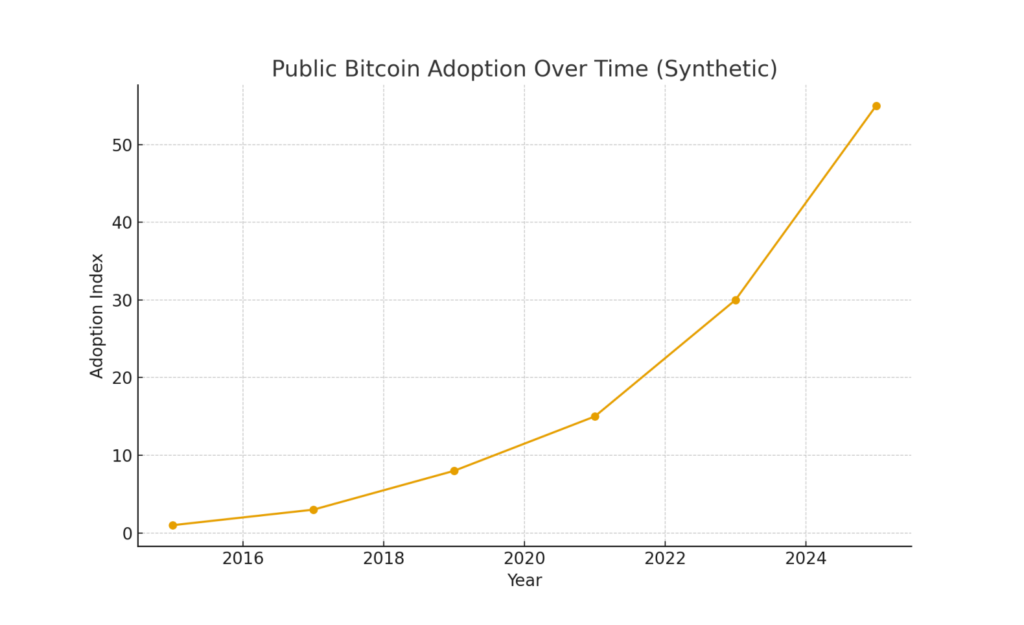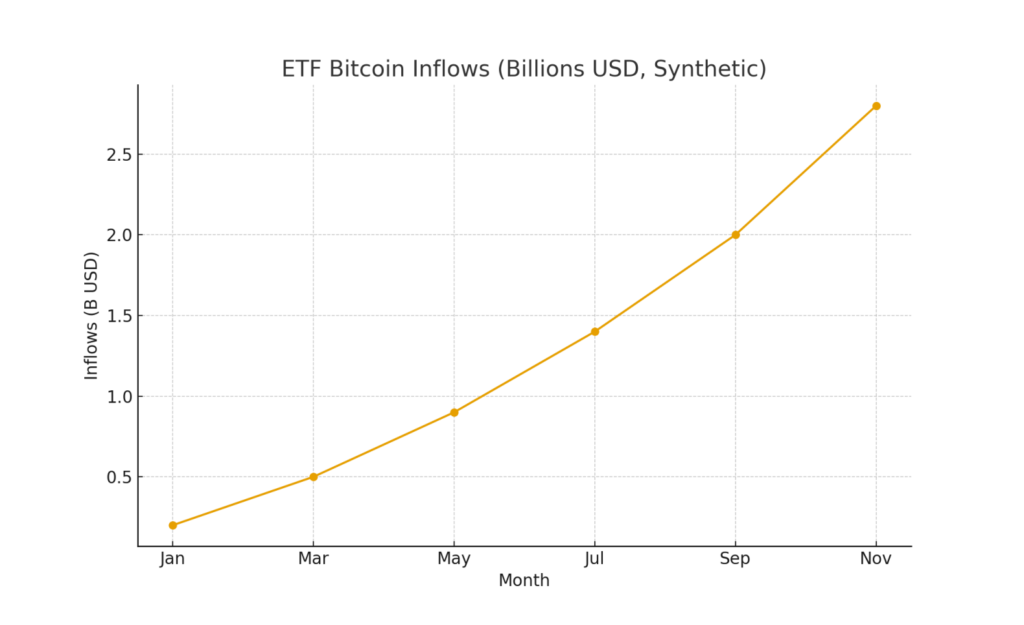
Main Points :
- U.S. state of Texas becomes the first state to officially purchase Bitcoin through a regulated ETF.
- Public sector recognition of Bitcoin shifts from a speculative asset to a legitimate long-term store of value.
- Regulated ETFs remove operational barriers for public institutions.
- Texas’s move likely triggers a domino effect among other states and large public pension funds.
- This development strengthens long-term market stability for Bitcoin and the broader digital asset ecosystem.
1. The Public Sector’s Recognition of Bitcoin as a Legitimate Asset
The decision by the State of Texas to purchase Bitcoin marks a dramatic evolution in how public-sector institutions evaluate digital assets. For years, Bitcoin was primarily viewed as a speculative instrument—volatile, unpredictable, and unsuitable for government-level financial management.
Texas’s decision to acquire approximately $52 million worth of Bitcoin via BlackRock’s Bitcoin ETF represents more than an investment; it signals a fundamental shift in perception. Public institutions are beginning to view Bitcoin not merely as a risky experiment but as a macro-hedge against inflation, a scarce digital commodity, and a portfolio stabilizer in an increasingly uncertain global economic environment.
Texas is not simply engaging in a symbolic gesture. Instead, it is formally positioning Bitcoin alongside traditional public assets such as bonds, treasuries, gold, and diversified equity holdings. This is clear evidence that Bitcoin has reached a level of institutional maturity and recognition that was nearly unthinkable a decade ago.
Why This Matters to the Market
Public sector investment represents one of the strongest forms of validation available in financial markets. When a government decides that an asset is stable enough, secure enough, and regulated enough to be part of public funds, it sends a global signal that the asset class has entered the highest tier of institutional credibility.
This shift will almost certainly influence:
- Treasury departments
- State-owned investment offices
- Public university endowments
- Sovereign entities in other countries
- Large pension systems managing hundreds of billions
And as more institutions consider Bitcoin a legitimate portfolio component, the long-term demand curve strengthens dramatically.
2. ETFs as the Gateway: Removing Barriers for Public Institutions
Texas chose to invest through BlackRock’s Bitcoin ETF, and this detail is central to understanding how public adoption becomes possible.
For a decade, the major barriers preventing states, municipalities, and pension funds from accessing Bitcoin included:
- Custody complexity
- Private key management
- Regulatory uncertainty
- Accounting and audit complications
- Security risks and insurance issues
A regulated ETF eliminates these concerns entirely.
Under an ETF structure:
- BlackRock handles custody.
- Coinbase Custody provides insured cold-storage solutions.
- Auditing and reporting follow U.S. GAAP and SEC disclosure standards.
- Institutions can treat BTC like any other ETF on their balance sheets.
This transforms Bitcoin from a technical challenge into a simple, compliant, auditable financial instrument.
ETF as the Institutional On-Ramp
BlackRock, Fidelity, and other major asset managers effectively built a highway for institutional capital to flow into Bitcoin safely. For public entities—particularly state governments bound by strict statutory and fiduciary mandates—this makes all the difference.
Texas’s move demonstrates that:
- Public entities can comply with laws
- Bitcoin exposure can be professionally custodied
- ETF structures fit into existing risk frameworks
This ETF-format gateway may become the standardized model through which future public adoption accelerates.
3. The Ripple Effect Across States and Public Pension Funds
When Texas becomes the first U.S. state to adopt Bitcoin, it is not an isolated financial decision; it is a catalyst.
Public pension funds control more than $5.6 trillion in assets across the United States. Even a tiny allocation—such as 0.1%—would generate billions of dollars in organic demand.
Historically, institutional adoption follows a pattern:
- A market leader takes the first step.
- Others conduct internal reviews.
- The “wait-and-see” period shortens.
- More institutions enter, seeking not to fall behind.
Texas has now placed itself in the role of market leader.
Why Pension Funds Are Likely Next
Public pension funds have:
- Long-term investment horizons
- Large-scale actuarial obligations
- Motivation to diversify away from inflation-sensitive assets
- Growing pressure to consider non-correlated alternatives
Bitcoin checks all of these boxes.
Moreover, with ETFs eliminating custody challenges, pension boards and investment committees can treat Bitcoin as another institutional-grade asset—no different from real estate investment trusts, commodities ETFs, or foreign treasury ETFs.
Potential Immediate Followers
Based on political climate, investment history, and innovation tendencies, the next likely adopters could include:
- Wyoming, known for pro-crypto frameworks
- Florida, which has history of aggressive diversification in state reserves
- Colorado and Arizona, states with large tech-forward constituencies
Internationally, sovereign wealth funds in Singapore, Norway, UAE, and Qatar may reassess their exposure to Bitcoin, particularly given increasing competition among global reserves.
Once pension funds and sovereign entities start allocating, Bitcoin may enter a third wave of institutional adoption, following:
- Retail (2010–2016)
- Public companies & hedge funds (2018–2023)
- Governments & public institutions (2025–onward)
Texas’s action could be seen as the official beginning of Phase 3.
4. Long-Term Impact: Stability, Liquidity, and Market Maturity
The entry of government-backed institutions fundamentally changes Bitcoin’s market structure.
A. Reduced Volatility
Public funds typically:
- Buy gradually
- Hold long-term
- Do not engage in speculative selling
This contributes to a more stable demand base, reducing volatility over multi-year periods.
B. Increased Liquidity Efficiency
ETF providers create large, predictable liquidity channels.
This allows:
- Narrower spreads
- More efficient market making
- Larger block trades
- Improved price discovery
C. Stronger Regulatory Foundation
If public entities are investing through regulated structures, regulators are incentivized to maintain clarity, fairness, and safety in the digital asset ecosystem.
D. Strengthening Bitcoin’s Role as a Macro Asset
Bitcoin increasingly assumes the characteristics of:
- Digital gold
- Global inflation hedge
- A non-sovereign reserve asset
- A hedge against currency debasement
- An uncorrelated alternative for public funding stability
Institutional adoption transforms Bitcoin’s narrative from speculative tech to global macroeconomic infrastructure.
5. Recent Trends: Bitcoin’s Global Institutional Momentum
In 2024–2025, several trends aligned to accelerate Bitcoin’s mainstream adoption:
1. ETF-driven record inflows
U.S. ETFs collectively exceeded $20B in cumulative inflows, surpassing early expectations.
2. Corporate adoption expanded
Companies like MicroStrategy continued increasing holdings, reinforcing treasury adoption narratives.
3. International central banks exploring Bitcoin
Some emerging markets have explored Bitcoin as:
- A reserve diversification asset
- A tool for mitigating local currency inflation
4. Banking sector integration
Major U.S. banks began supporting Bitcoin custody for institutional clients.
5. Hashrate growth reinforcing network security
Bitcoin’s hashrate reached all-time highs in 2025, increasing network resilience and investor confidence.
Together, these trends create a macro environment where state-level adoption—once unthinkable—is now logical and timely.
Figure 1: Public Bitcoin Adoption Over Time

Figure 2: ETF Bitcoin Inflows

Conclusion: Texas Has Opened the Floodgates
Texas’s Bitcoin purchase is not merely a financial transaction; it is a declaration that the world’s largest decentralized asset has entered the realm of legitimate public finance.
This move will likely:
- Encourage other states to evaluate Bitcoin allocations
- Influence public pension funds
- Strengthen global regulatory clarity
- Accelerate Bitcoin’s evolution into a macroeconomic asset
In the years ahead, analysts may look back on Texas’s decision as the moment when the public sector officially entered the Bitcoin era, initiating one of the most important adoption waves in digital asset history.

